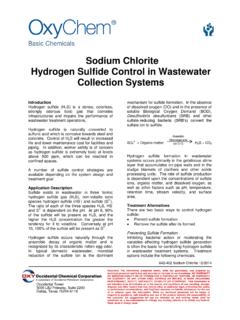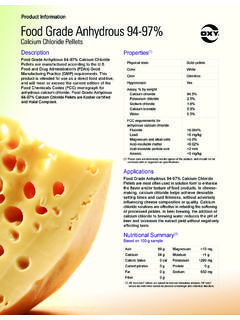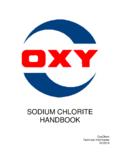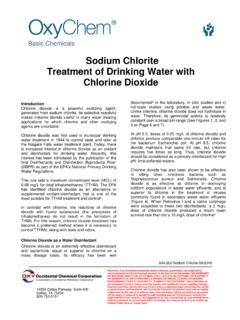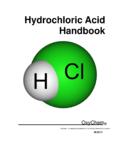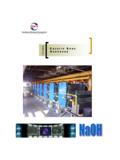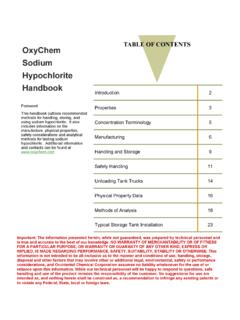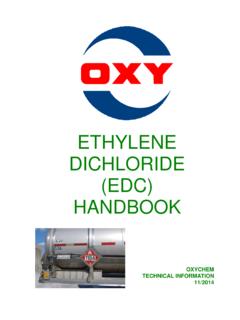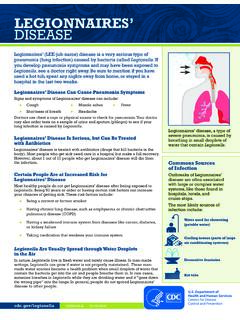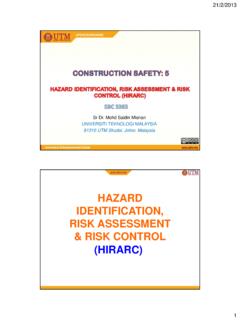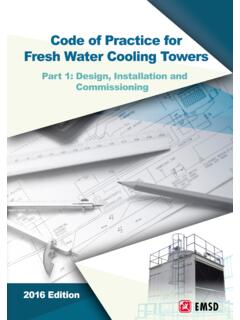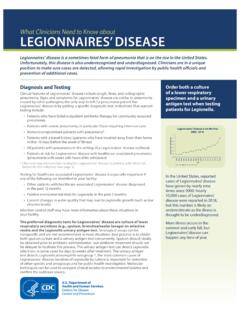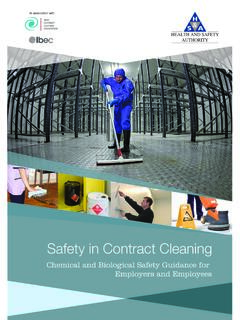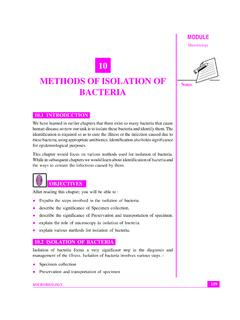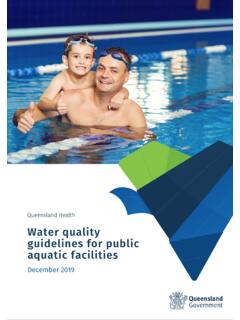Transcription of Sodium Chlorite Treatment of Drinking Water with Chlorine ...
1 Basic Chemicals 600-202 Sodium Chlorite 08/2018 Important: The information presented herein, while not guaranteed, was prepared by technical personnel and is true and accurate to the best of our knowledge. NO WARRANTY OF MERCHANTABILITY OR OF FITNESS FOR A PARTICULAR PURPOSE, OR WARRANTY OR GUARANTY OF ANY OTHER KIND, EXPRESS OR IMPLIED, IS MADE REGARDING PERFORMANCE, SAFETY, SUITABILITY, STABILITY OR OTHERWISE. This information is not intended to be all-inclusive as to the manner and conditions of use, handling, storage, disposal and other factors that may involve other or additional legal, environmental, safety or performance considerations, and Occidental Chemical Corporation assumes no liability whatsoever for the use of or reliance upon this information. While our technical personnel will be happy to respond to questions, safe handling and use of the product remains the responsibility of the customer. No suggestions for use are intended as, and nothing herein shall be construed as, a recommendation to infringe any existing patents or to violate any Federal, State, local or foreign laws.
2 14555 Dallas Parkway, Suite 400 Dallas, TX 75254 800-752-5151 Sodium Chlorite Treatment of Drinking Water with Chlorine Dioxide Introduction Chlorine dioxide is a powerful oxidizing agent, generated from Sodium Chlorite . Its selective reactivity makes Chlorine dioxide useful in many Water treating applications for which Chlorine and other oxidizing agents are unsuitable. Chlorine dioxide was first used in municipal Drinking Water Treatment in 1944 to control taste and odor at the Niagara Falls Water Treatment plant. Today, there is increased interest in Chlorine dioxide as an oxidant and disinfectant for Drinking Water . Recently, this interest has been stimulated by the publication of the final Disinfectants and Disinfection Byproducts Rule1 (DBPR) as part of the EPA's National Primary Drinking Water Regulations. This rule sets a maximum contaminant level (MCL) of mg/L for total trihalomethanes (TTHM).
3 The EPA has identified Chlorine dioxide as an alternative or supplemental oxidant-disinfectant that is one of the most suitable for TTHM Treatment and control2. In contrast with Chlorine , the reactions of Chlorine dioxide with humic substances (the precursors of trihalomethanes) do not result in the formation of THMs. For this reason, Chlorine dioxide Treatment has become a preferred method where it is necessary to control TTHMs, along with taste and odors. Chlorine Dioxide as a Water Disinfectant Chlorine dioxide is an extremely effective disinfectant and bactericide, equal or superior to Chlorine on a mass dosage basis. Its efficacy has been well documented3 in the laboratory, in pilot studies and in full-scale studies using potable and waste Water . Unlike Chlorine , Chlorine dioxide does not hydrolyze in Water . Therefore, its germicidal activity is relatively constant over a broad pH range (See Figures 1, 2, and 3 on Page 6 and 7).
4 At pH , doses of mg/L of Chlorine dioxide and Chlorine produce comparable one-minute kill rates for the bacterium Escherichia coli. At pH , Chlorine dioxide maintains that same kill rate, but Chlorine requires five times as long. Thus, Chlorine dioxide should be considered as a primary disinfectant for high pH, lime-softened waters. Chlorine dioxide has also been shown to be effective in killing other infectious bacteria such as Staphylococcus aureus and Salmonella. Chlorine dioxide is as effective as Chlorine in destroying coliform populations in waste Water effluents, and is superior to Chlorine in the Treatment of viruses commonly found in secondary waste Water effluents (Figure 4). When Poliovirus I and a native coliphage were subjected to these two disinfectants, a 2 mg/L dose of Chlorine dioxide produced a much lower survival rate than did a 10 mg/L dose of chlorine4.
5 Basic Chemicals 600-202 Sodium Chlorite 08/2018 Important: The information presented herein, while not guaranteed, was prepared by technical personnel and is true and accurate to the best of our knowledge. NO WARRANTY OF MERCHANTABILITY OR OF FITNESS FOR A PARTICULAR PURPOSE, OR WARRANTY OR GUARANTY OF ANY OTHER KIND, EXPRESS OR IMPLIED, IS MADE REGARDING PERFORMANCE, SAFETY, SUITABILITY, STABILITY OR OTHERWISE. This information is not intended to be all-inclusive as to the manner and conditions of use, handling, storage, disposal and other factors that may involve other or additional legal, environmental, safety or performance considerations, and Occidental Chemical Corporation assumes no liability whatsoever for the use of or reliance upon this information. While our technical personnel will be happy to respond to questions, safe handling and use of the product remains the responsibility of the customer. No suggestions for use are intended as, and nothing herein shall be construed as, a recommendation to infringe any existing patents or to violate any Federal, State, local or foreign laws.
6 14555 Dallas Parkway, Suite 400 Dallas, TX 75254 800-752-5151 When applied for disinfection (as opposed to oxidation), a disinfectant must provide specified levels of microorganism kills or inactivations as measured by reductions of coliforms, heterotrophic plate count organisms and legionella bacteria . Under current regulations5, the disinfection Treatment must be sufficient to ensure at least a percent (3-log) removal and/or inactivation of Giardia lamblia cysts and percent (4-log) removal and/or inactivation of enteric viruses. Disinfection is expressed as a CT value ( , a function of Concentration x Contact Time). At the CT values necessary for Chlorine dioxide to inactivate percent of Giardia lamblia cysts, the simultaneous inactivation of percent of enteric viruses is also assured. These regulations also establish Treatment technique requirements in lieu of MCLs for Giardia lamblia, viruses and legionella .
7 The published CT values (40 CFR ) required for various disinfectants to achieve these goals show that Chlorine dioxide is more effective than Chlorine or monochloramine. Over the pH 6-9 range, Chlorine dioxide is at least twice as effective as free Chlorine is at pH 6. At pH 7-9, free Chlorine becomes progressively less effective than Chlorine dioxide. Chlorine dioxide is also substantially more effective than monochloramine. Chlorine Dioxide For Control Of THMs In 1974, researchers first observed the formation of trihalomethanes (THMs) during chlorination of natural waters. These THMs (chloroform, bromodichloro-methane, dibromochloromethane, and bromoform) are produced when free Chlorine or bromine reacts with natural organic matter in the Water . The subsequent identification of THMs in chlorinated Water supplies led to concerns over their potential health effects.
8 These concerns include potential reproductive effects and the classification of chloroform, bromodichloromethane and certain other disinfection byproducts (DBPs) as carcinogens. In 1979, the EPA established a THM Maximum Contaminant Level (MCL) of mg/L, causing Water utilities to begin searching for alternatives to Chlorine for oxidation and disinfection of Water . The recent DBPR1 not only lowered the MCL for total trihalomethanes (TTHMs) to mg/l, but also extended the MCL to all size systems. In addition, a new MCL of mg/L was established for haloacetic acids (HAA5). As a result, there is an increased emphasis on the modification of Water Treatment methods to prevent or reduce the formation of THMs and other DBPs to ensure compliance with the new EPA rule. For this purpose, Chlorine dioxide is an excellent choice as either an alternative or supplemental oxidant-disinfectant.
9 The key to understanding why Chlorine dioxide is so effective can be found in the differences in the reactions of Chlorine dioxide and Chlorine with THM precursors, such as humic and fulvic acids. Chlorine Basic Chemicals 600-202 Sodium Chlorite 08/2018 Important: The information presented herein, while not guaranteed, was prepared by technical personnel and is true and accurate to the best of our knowledge. NO WARRANTY OF MERCHANTABILITY OR OF FITNESS FOR A PARTICULAR PURPOSE, OR WARRANTY OR GUARANTY OF ANY OTHER KIND, EXPRESS OR IMPLIED, IS MADE REGARDING PERFORMANCE, SAFETY, SUITABILITY, STABILITY OR OTHERWISE. This information is not intended to be all-inclusive as to the manner and conditions of use, handling, storage, disposal and other factors that may involve other or additional legal, environmental, safety or performance considerations, and Occidental Chemical Corporation assumes no liability whatsoever for the use of or reliance upon this information.
10 While our technical personnel will be happy to respond to questions, safe handling and use of the product remains the responsibility of the customer. No suggestions for use are intended as, and nothing herein shall be construed as, a recommendation to infringe any existing patents or to violate any Federal, State, local or foreign laws. 14555 Dallas Parkway, Suite 400 Dallas, TX 75254 800-752-5151 dioxide reacts primarily by oxidation; however, Chlorine reacts by both oxidation and electrophilic substitution to yield volatile and nonvolatile chlorinated organic substances (THMs). 05101520253035404550020406080100120 Reaction time (hours)Chloroform Concentration (ug/L) Chlorine DioxideFree ChlorineFigure 5 Chloroform production in Water containing 5 mg humic aciddosed with Chlorine dioxide or free Chlorine Many Treatment methods have been developed to remove THMs once they have been formed by Chlorine Treatment . However, Chlorine dioxide Treatment method is superior in preventing or substantially reducing their initial formation.
